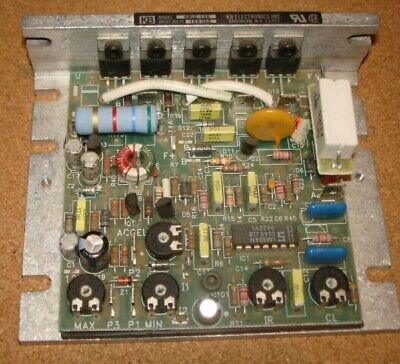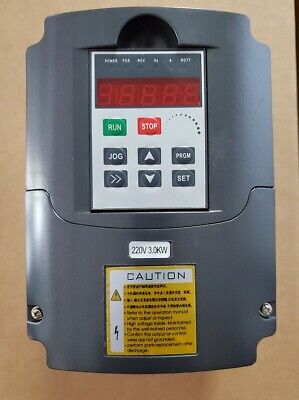Thank you so much. Over the past 2 months I have talked to innumerable reps from KB themselves, Galco, and whatever other big reputable manufacturer or distributor and not one has suggested the KBLC120, yet it appears to be the exact controller that I described as ideally looking for (and at $85 new, also 1/3 the price of what was often suggested...which is so frustrating and disheartening...) Anyhow, I just read the provided manual with that drive and it appears to be pretty close to spot on and if wired up in a decent enclosure with a heat sink and fan, appropriate resistor, and some fuse, that it should perform quite well for quite some time. Thank you very much for sharing that, and this goes to everyone, thank you very very much for sharing your knowledge and time in general!Ebay has them, here's one that's been tested: price is reasonable at 40$. Some of the prices are outrageously high IMO

KBLC-120 120VAC Input DC Motor Speed Control, Used, Tested | eBay
KBLC-120 120VAC Input DC Motor Speed Control, Used, Tested. Condition is "Used". Shipped with USPS Priority Mail.www.ebay.com
-
Welcome back Guest! Did you know you can mentor other members here at H-M? If not, please check out our Relaunch of Hobby Machinist Mentoring Program!
You are using an out of date browser. It may not display this or other websites correctly.
You should upgrade or use an alternative browser.
You should upgrade or use an alternative browser.
Are people still using DC motors to power their machines?
- Thread starter sdy5001
- Start date
Can you share which VFD you are using?I put a 2hp BALDOR with VFD on my mill. Very impressed with low speed torque especially when power tapping. I limited my bottom end at 30hz although the documentation says 15 hz can be used safely. I kept the standard stepped pulley setup so my speed range went from 120 - 2500 to 60 - 5000. The only slight snafu I've encountered is my brake setting. I keep the brake force high so I get instant reverse when power tapping which is awesome BUT the VFD will trip due to overcurrent if I shut the mill down suddenly from speeds above 3000 rpm as the electronic brake tries to overcome the inertia of all those pullies and belts in just a few seconds. I can avoid this by increasing the brake interval but I prefer to just wind it down a bit with the HZ dial before stopping from high RPM.
Is there a 'cheap vfd' you recommend for something single phase in the 2hp range? That is the tentative plan for my upcoming mill project, which I expect to get underway in about 2 weeks so I'll be ordering a setup quite soon....MC40,MC60,MC80 boards are great for driving DC motors
KBC drives are proven assets
Dart drives are great DC drives
treadmill motors work very well
I work with higher end VFD's equipped on the machines i work on, but i use very inexpensive VFD's in my shop
My philosophy is that i can buy 3 or 4 inexpensive drives for the cost of a high end drive
the high end drives don't really power the machines any better than the low end drives in my experience
i have not had a single failure or experienced any of the horror stories others will lead you to believe.
this is on heavily used equipment- milling machines, lathes, surface grinders, pedestal grinders, tool and cutter grinders
for this experiment of 8 years on varying equipment and many cheap VFD's , i'll give the inexpensive VFD's a nod of confidence.
i figure if i do ever loose a VFD, i'll spend only a few $$$ and be up and running again
instead of spending for several hundred or up to thousands on a drive, i have been stocking my toolboxes with the money i have saved
the best motors to use with VFD's are inverter rated, but don't let that stop you
most motors can safely be operated for short periods of time out of the 60Hz envelope
a safe zone is 30 to 90 Hz for normal induction motors
for inverter rated motors the envelope can be very low 5hz or so up to 400Hz
- Joined
- Apr 8, 2013
- Messages
- 1,982
This is the one I got from from AMAZON. It's a MYSWEETYCan you share which VFD you are using?
- Joined
- Apr 8, 2013
- Messages
- 1,982
VFDs only work with 3 phase motors.Is there a 'cheap vfd' you recommend for something single phase in the 2hp range? That is the tentative plan for my upcoming mill project, which I expect to get underway in about 2 weeks so I'll be ordering a setup quite soon....
- Joined
- Feb 2, 2013
- Messages
- 3,628
i have this model on my Shenwai 1236 latheIs there a 'cheap vfd' you recommend for something single phase in the 2hp range? That is the tentative plan for my upcoming mill project, which I expect to get underway in about 2 weeks so I'll be ordering a setup quite soon....
it performs flawlessly

Variable Frequency Drive / Inverter 3kW 4HP 220v 3 Phase | eBay
3KW 220V 4HP 3 Phase 13A VFD Variable Frequency Drive Inverter. Frequency Drive 220 Volt, 3KW (4HP), Three Phase. Input : 1 or 3 phase 220V/ Output : 3 phase 220v. Frequency : 0-50hz/60hz.
www.ebay.com
- Joined
- Feb 2, 2013
- Messages
- 3,628
not exactly.VFDs only work with 3 phase motors.
folks have successfully hooked VFD's up to single phase motors
some motors are not good candidates without modification, namely capacitor start and capacitor run motors
- Joined
- Apr 8, 2013
- Messages
- 1,982
I stand corrected, never heard of that before.not exactly.
folks have successfully hooked VFD's up to single phase motors
some motors are not good candidates without modification, namely capacitor start and capacitor run motors
- Joined
- Feb 2, 2013
- Messages
- 3,628
i didn't think it was possible either, until i saw a working motor/vfd set upI stand corrected, never heard of that before.

- Joined
- Feb 1, 2015
- Messages
- 9,623
The VFD's for single phase motors that I have seen have largely been used to control things like fan motors. Fans have a low torque requirement at low rpm. As I recall, the torque required is proportional to air flow velocity cubed and by extension, roughly to rpm cubed.
Ac induction motors have a speed determined by line frequency. This is true whether the motor is single phase or a split phase. In theory, changing the line frequency should change the motor speed and this should apply to both single or three phase motors. The rub occurs with capacitor start motors because as the speed drops, the start circuit kicks in. The start circuit is designed for short cycle times and will quickly overheat with prolonged operation. Thus, VFD's have been considered unusable for single phase capacitor start motor.
There are a couple of options available for VFD operation on single phase capacitor start motors. One would be to change the centrifugal switch characteristics. Anyone who has dealt with a bad capacitor, switch, or start winding is aware that you can start the motor by turning the motor by hand in the desired direction. Ir only takes a few rpm to activate the motor. If the switch were modified by either adding weight to the centrigugal weight or decreasing the spring force, the start switch will cut out at a lower rpm. If that rpm is below the typical operating range, the motor should behave well.
Another way to use a VFD on a single phase capacitor is to remove the capacitor and switch. The start winding is then treated as a second leg of a three phase motor. The VFD modifies the current in the second leg to prevent overheating and the motor runss. I expect that VFFD's specifically designed to operate single phase motors are capable of varying the phase relationship from the typical 120º difference to optimize operation.
This is a theoretical discussion. I haven't actually attempted this myself and modern VFD's are sophosticate devices capable of controlling a multitude of parameters. My original interest was to use the OEM single phase motor on my G0602 lathe as the assigned space requirements are strict. My hesitancy was largely based on low end torque specifications and I couldn't find performance curves. My p4rimary desire was not to increase high end rpm but to decrease low end rpm. The low end of the operating range on the OEM lathe was 150 rpm. There are times when I would like to drop that to more like 50 rpm. With now guarantee of adequate operation, I was hesitant to invest several hundred dollars in an experiment.
Ac induction motors have a speed determined by line frequency. This is true whether the motor is single phase or a split phase. In theory, changing the line frequency should change the motor speed and this should apply to both single or three phase motors. The rub occurs with capacitor start motors because as the speed drops, the start circuit kicks in. The start circuit is designed for short cycle times and will quickly overheat with prolonged operation. Thus, VFD's have been considered unusable for single phase capacitor start motor.
There are a couple of options available for VFD operation on single phase capacitor start motors. One would be to change the centrifugal switch characteristics. Anyone who has dealt with a bad capacitor, switch, or start winding is aware that you can start the motor by turning the motor by hand in the desired direction. Ir only takes a few rpm to activate the motor. If the switch were modified by either adding weight to the centrigugal weight or decreasing the spring force, the start switch will cut out at a lower rpm. If that rpm is below the typical operating range, the motor should behave well.
Another way to use a VFD on a single phase capacitor is to remove the capacitor and switch. The start winding is then treated as a second leg of a three phase motor. The VFD modifies the current in the second leg to prevent overheating and the motor runss. I expect that VFFD's specifically designed to operate single phase motors are capable of varying the phase relationship from the typical 120º difference to optimize operation.
This is a theoretical discussion. I haven't actually attempted this myself and modern VFD's are sophosticate devices capable of controlling a multitude of parameters. My original interest was to use the OEM single phase motor on my G0602 lathe as the assigned space requirements are strict. My hesitancy was largely based on low end torque specifications and I couldn't find performance curves. My p4rimary desire was not to increase high end rpm but to decrease low end rpm. The low end of the operating range on the OEM lathe was 150 rpm. There are times when I would like to drop that to more like 50 rpm. With now guarantee of adequate operation, I was hesitant to invest several hundred dollars in an experiment.

